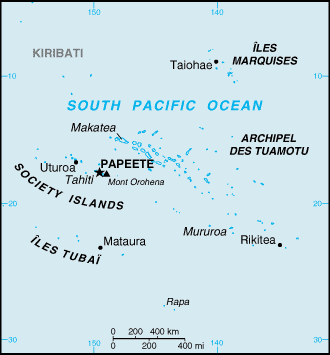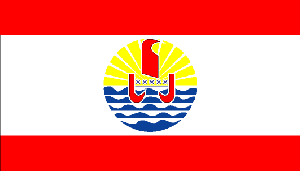
|
French Polynesia
Background:
The French annexed various Polynesian island groups during the 19th century. In
September 1995, France stirred up widespread protests by resuming nuclear
testing on the Mururoa atoll after a three-year moratorium. The tests were
suspended in January 1996.
Location:
Oceania, archipelago in the South Pacific Ocean, about one-half of the way from
South America to Australia.
Area: Total: 4,167 sq km (118 islands and atolls,) water: 507 sq km, land:
3,660 sq km.
Area - comparative: Slightly less than one-third the size of Connecticut.
Coastline: 2,525 km.
Climate and Terrain:
Climate: Tropical, but moderate.
Terrain: Mixture of rugged high islands and low islands with reefs.
Elevation extremes: Lowest point: Pacific Ocean 0 m, highest point: Mont
Orohena 2,241 m.
Natural resources: Timber, fish, cobalt, hydropower.
People:
Population: 257,847.
Ethnic groups: Polynesian 78%, Chinese 12%, local French 6%, metropolitan
French 4%.
Religions: Protestant 54%, Roman Catholic 30%, other 16%.
Languages: French (official), Tahitian (official.
Government:
Dependency status: Overseas territory of France since 1946.
Capital: Papeete.
Economy overview:
Since 1962, when France stationed military personnel in the region, French
Polynesia has changed from a subsistence economy to one in which a high
proportion of the work force is either employed by the military or supports the
tourist industry. With the halt of French nuclear testing in 1996, the military
contribution to the economy fell sharply. Tourism accounts for about one-fourth
of GDP and is a primary source of hard currency earnings. Other sources of
income are pearl farming and deep-sea commercial fishing. The small
manufacturing sector primarily processes agricultural products. The territory
substantially benefits from development agreements with France aimed
principally at creating new businesses and strengthening social services.
GDP - composition by sector: Agriculture: 6%, industry: 18%, services: 76%.
Statistics:
Telephones - main lines in use: 52,000.
Telephones - mobile cellular: 5,427.
Radio broadcast stations: AM 2, FM 14.
Radios: 128,000.
Television broadcast stations: 7 (plus 17 low-power repeaters).
Televisions: 40,000.
Internet users: 5,000.
Railways: 0 km.
Highways: Total: 792 km, paved: 264 km. unpaved: 528 km.
Waterways: none
Airports: 45,
with paved runways: 33,
with unpaved runways: 12.
Return to Visiting Locations
|

